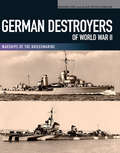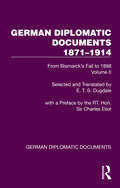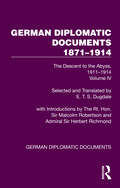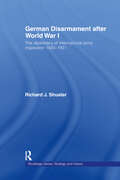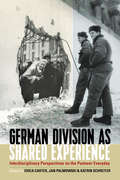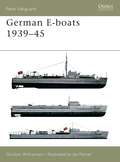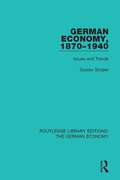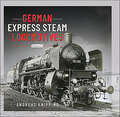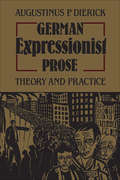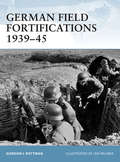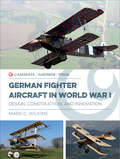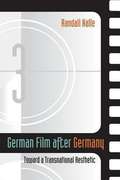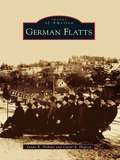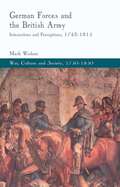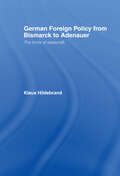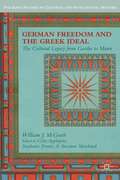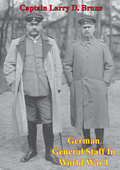- Table View
- List View
German Destroyers of World War II: Warships of the Kriegsmarine (Warships Of The Kriegsmarine Ser.)
by Gerhard Koop Klaus-Peter SchmolkeA detailed, illustrated history of the torpedo boat destroyers of the Nazi German Navy. The warships of the World War II German Navy are among the most popular subjects in naval history, and one of the best collections is the concise but authoritative six volume series written by Gerhard Koop and illustrated by Klaus-Peter Schmolke. Each book contains an account of the development of a particular class, a detailed description of the ships, with full technical details, and an outline of their service, and are heavily illustrated with plans, battle maps and a substantial collection of photographs. This volume in the series details the more than 40 German destroyers, including captured ships that saw service during World War II. Chapters range from their design and development, armament and machinery, to the differences in appearance, camouflage schemes, and modifications. This book also covers the destroyers&’ careers and the many actions they fought, complemented by illustrated plans, technical drawings, maps, and a comprehensive gallery of photographs.
German Diplomatic Documents 1871–1914 Volume 1: Bismarck’s Relations with England 1871–1890 (German Diplomatic Documents 1871–1914)
by Dugdale, E. T. S. Rennell Rodd Headlam-Morley, J. W.Originally published in English in 1928, this volume deals mainly with Anglo-German relations at the end of the 19th Century. Chancellor Otto von Bismarck’s voice can be heard clearly in the documents which give an extensive picture of the alternating phases of relations between Great Britain and Germany, as influenced by their respective obligations and interests in the international issues which united or divided the Powers over a period of twenty years. The strongest impression which these documents leave is the revelation of how greatly the mentality of the western world changed since they were drafted, and especially during the decade which came after World War I. The shaping of policy, as exhibited in these despatches and memoranda, is governed almost exclusively by the ultimate idea of war as the deciding factor. The menace of war and the prospects of success or failure in aggression or defence appear to be the essential motives of policy.
German Diplomatic Documents 1871–1914 Volume 2: From Bismarck's Fall to 1898 (German Diplomatic Documents 1871–1914)
by Charles Eliot Dugdale, E. T. S.Originally published in English in 1929, this second volume of the German Diplomatic Documents covers a much shorter period: 1890–1898. During this period there was no war or revolution in Europe, but the sphere of German and indeed European politics became enlarged. The documents in this volume deal with questions raised by diverse regions such as Armenia, Morocco, Tunisia, Tripoli, South Africa, Crete and Cuba. The papers here reissued show that colonial expansion is a recognised part of the official German programme. As with the first volume, the policy exhibited in the despatches of this volume are governed almost exclusively by the ultimate idea of war.
German Diplomatic Documents 1871–1914 Volume 3: The Growing Antagonism 1898–1910 (German Diplomatic Documents 1871–1914)
by Dugdale, E. T. S. Maurice De BunsenOriginally published in 1930, this volume opens with some selections dealing with the situation created by the victory of Japan over China in 1904 which opened a new epoch in the history of the Far East. It includes two momentous conflicts profoundly affecting international relations – the Boer War and the Russo-Japanese War. It also touches at many points on the long discussions aiming at a naval agreement, with or without some form of general understanding, between England and Germany. Through the Alliance with Japan and the Entente with France it leads up to the separation of Europe into two rival camps, in the course of an evolution in which crisis followed crisis with increasing and often alarming intensity.
German Diplomatic Documents 1871–1914 Volume 4: The Descent to the Abyss, 1911–1914 (German Diplomatic Documents 1871–1914)
by Dugdale, E. T. S. Malcolm Robertson Herbert RichmondOriginally published in English in 1931, this fourth and final volume of documents brings the reader to the brink of World War I. The despatches beg the question of whether war was inevitable and if so, could it have been postponed? The question of whether the British Empire needed to have taken part in it, and how far its action or inaction was responsible for the outbreak is also discussed.
German Disarmament After World War I: The Diplomacy of International Arms Inspection 1920-1931 (Strategy and History)
by Richard J. ShusterGerman Disarmament After World War I examines the Allied disarmament of Germany and the challenges that such an enormous task presented to international efforts in enforcing the Treaty of Versailles. In the twenty-first century, disarmament remains a critical issue for the International community. This new book focuses on three key areas and lessons of Allied disarmament operations from 1920-31: the role and experience of international arms inspectors working amidst an embittered German populace the ramifications of the divergent disarmament priorities of the leaders of the disarmament coalition the effectiveness of united Allied policies backed by sanctions. These major issues are examined within the overall context of the assessment of Allied disarmament operations in Germany. While some historians perceive German disarmament as a failure, this book argues that arms inspectors successfully destroyed Germany’s ability to pose a military threat to European security. This new study shows how the destructive legacy of war convinced the victorious nations, especially Britain and France, of the importance in minimizing German military strength. French post-war security concerns, however, were often faced with the unwillingness of Britain to enforce the totality of the military articles of the treaty. German obstruction also influenced Allied disarmament policies. German Disarmament After World War I examines the initial effectiveness of Allied disarmament efforts in Germany and explains how they ultimately disappeared through diverging conceptions of a post-war world. This book will be of great interest to all students of disarmament, the interwar period and of military history, modern European history and security studies.
German Division as Shared Experience: Interdisciplinary Perspectives on the Postwar Everyday
by Jan Palmowski Erica Carter Katrin SchreiterDespite the nearly three decades since German reunification, there remains little understanding of the ways in which experiences overlapped across East-West divides. German Division as Shared Experience considers everyday life across the two Germanies, using perspectives from history, literary and cultural studies, anthropology and art history to explore how interconnections as well as fractures between East and West Germany after 1945 were experienced, lived and felt. Through its novel approach to historical method, the volume points to new understandings of the place of narrative, form and lived sensibility in shaping Germans’ simultaneously shared and separate experiences of belonging during forty years of division from 1945 to 1990.
German Division as Shared Experience: Interdisciplinary Perspectives on the Postwar Everyday
by Katrin Schreiter Erica Carter, Jan PalmowskiDespite the nearly three decades since German reunification, there remains little understanding of the ways in which experiences overlapped across East-West divides. German Division as Shared Experience considers everyday life across the two Germanies, using perspectives from history, literary and cultural studies, anthropology and art history to explore how interconnections as well as fractures between East and West Germany after 1945 were experienced, lived and felt. Through its novel approach to historical method, the volume points to new understandings of the place of narrative, form and lived sensibility in shaping Germans’ simultaneously shared and separate experiences of belonging during forty years of division from 1945 to 1990.
German E-boats 1939-45
by Ian Palmer Gordon WilliamsonBy the outbreak of World War II, Germany had done much to replace the Kaiser's High Seas Fleet, which was scuttled following their surrender at the end of World War I. Forced to build anew, the Kriegsmarine possessed some of the most technically advanced warships in existence. Although the heavy units of the fleet were too small in number to pose much of a threat, Germany was particularly well served by her Navy's smaller vessels, in particular the U-Boats and the S-Boats. Known to the allies as the E-Boats ('Enemy'), they performed sterling duties in the Black Sea and English Channel, where they became a particular scourge.
German Economy, 1870-1940: Issues and Trends (Routledge Library Editions: The German Economy #12)
by Gustav StolperOriginally published in 1940, this book remains an illuminating and forceful survey of the economic development of modern Germany. It reveals for the first time the basic trends of German business enterprise towards central control. This survey makes three important factors clear. Firstly, the continuity in the underlying trends of German history; secondly the characteristic prevalence of 'statism' in German history; thirdly, Nazism cannot be explained on purely economic grounds: no other county showed such a striking sequel of ups and downs as that which this book illustrates in the economic history of the late 19th and early 20th centuries.
German Exile Politics: The Social Democratic Executive Committee in the Nazi Era
by Lewis J. EdingerThis title is part of UC Press's Voices Revived program, which commemorates University of California Press’s mission to seek out and cultivate the brightest minds and give them voice, reach, and impact. Drawing on a backlist dating to 1893, Voices Revived makes high-quality, peer-reviewed scholarship accessible once again using print-on-demand technology. This title was originally published in 1956.
German Existentialism
by Martin Heidegger“On the day of German Labor, on the day of the Community of the People, the Rector of Freiburg University, Dr. Marin Heidegger, made his official entry into the National Socialist Party.” And so begins one of the most controversial philosophical texts available today. Heidegger, a German Nationalist and proud Nazi, thoroughly examines the history, the philosophy, and the rise to power of the Nazi movement in Germany. Martin Heidegger’s distinguished Italian colleague, Professor Benedetto Croce, said of his German contemporary, “This man dishonors philosophy and that is an evil for politics too.” Croce’s severe rebuke was not singular at the time when Hitlerism was rampant over Europe. It is true that among the almost one thousand professional philosophers of Germany and Austria only very few actively opposed National Socialism. On the other hand, no one degraded his historic profession in the manner Heidegger did, by becoming a spokesman for National Socialism and attempting to mold his theories into one pattern with Hitlerism. Heidegger’s contribution to the growth and development of National Socialism was immense. In this small anthology Dr. Runes endeavors to point to the utter confusion Heidegger created by drawing, for political and social application of his own existentialism metaphysics, upon the decadent and repulsive brutalization of Hitlerism. Martin Heidegger was a philosopher most known for his contributions to German phenomenological and existential thought. Heidegger was born in rural Messkirch in 1889 to Catholic parents. While studying philosophy and mathematics at Albert-Ludwig University in Freiburg, Heidegger became the assistant for philosopher Edmund Husserl. Influenced by Husserl, Kierkegaard, and Nietzsche, Heidegger wrote extensively on the quality of Being, including his opus Being and Time. He served as professor of philosophy at Albert-Ludwig University and taught there during the war. In 1933, Heidegger joined the National Socialist German Worker’s (or Nazi) Party and expressed his support for Hitler in several articles and speeches. After the war, his support for the Nazi party came under attack, and he was tried as a sympathizer. He was able to return to Albert-Ludwig University, however, and taught there until he retired. Heidegger continued to lecture and write until his death 1973.
German Express Steam Locomotives
by Andreas KnippingIn this book, the author defines the express stem locomotive on the basis of the mandatory criterion of large drive wheels, and studies its evolution from around 1850 to the last refinements made around 1960, with many wrong turns and great successes along the way. This highly illustrated work features over 6,000 German express steam locomotives, including the oldest, the 1A1 and the Crampton; the largest, the Prussian S3; the fastest, the Reichsbahn-05; arguably the most successful, the Bavarian S3/6; and the most powerful, the Bundesbahn's oil-fired three-cylinder 01.
German Expressionist Prose: Theory and Practice
by Augustinus DierickAn extreme sensitivity to gathering social crisis, an accompanying angry enthusiasm for artistic experimentation and renewal – this compelling mix in German art, poetry, and drama of the period 1910 to 1925 continues to draw both scholarly attention and intense popular interest. In this book Augustinus Dierick focuses on another significant but hitherto neglected medium of German Expressionist thought – short narrative prose – in order to illuminate and evaluate the contribution of that genre to one of the twentieth century's most powerful artistic movements. Dierick's study includes a thorough analysis of the works of a broad range of Expressionist prose writers, from those of such specialists in the genre as Edschmid, Heym, Benn, Loerke, Frank, Sternheim, Ehrenstein, and 'Mynona' to the shorter prose works of such major figures as Alfred Döblin, Heinrich Mann, Max Brod, and Franz Werfel. Dierick isolates the thematic obsessions common among Expressionist writers: the pathos of the self in confrontation with nature and with God, the tension between self and the institutions of bourgeois society, and the attractions and dangers of eroticism. Throughout Dierick stresses the interrelationship between themes and their formal expression. He examines many apparent excesses in style and tone, many aberrations in structure and generic characteristics, and identifies them not as needless experimentation but as a necessary result of the attempt to find appropriate forms for extreme situations and complex ideas. Dierick's analysis makes clear that Expressionist prose has an intrinsic artistic value and, because of certain nuances and different accents, must be included in any estimation of the nature and importance of Expressionism as a whole.
German Fantasia
by Philippe ClaudelA deserting soldier treks through the torn-up countryside and abandoned villages, trying to distance himself from the atrocities of war.An elderly man sits beneath lime trees, remembering his first sexual encounter one summer night with a female stranger who whispered another man's name.A young woman takes up a job in a care home, spending monotonous days scrubbing floors and yearning to dance at the local nightclub.The artist Franz Marc lives on in an imagined life as a patient at an asylum, before falling victim to Hitler's policy of Gnadentod.Finally, a young Jewish girl, the life she once knew destroyed, holds her memories close as she finds refuge in wreckage of her homeland.And throughout there is the shadowy presence of Viktor - one man or many? A looming figure in Germany's own reckoning with its past.Through these five interconnected stories, Philippe Claudel reflects on Germany's complex history and the experiences of its people, dismantling the idea of "a nation" or "a people" and exploring the malleability of memory.
German Façade Design: Traditions of Screening from 1500 to Modernism
by Randall OttGerman architecture prior to the modern period has received less systemic, analytical study than that of Italy, France, and Britain. Scholarly discussion of broad traditions or continuities within Germanic or Central European façade design is even sparser. Baroque era studies of the region mostly devote themselves to isolated architects, monuments, or movements. Modernism's advent decisively changed this: Germanic architecture enjoyed sudden ascendancy. Yet, even so, study specifically of that region's façades still lagged – nothing compares to the dozens of treatments of Le Corbusier's façade systems, for example, and how these juxtapose with French neoclassical or Italian Renaissance methods. Given the paucity of multi-period studies, one can be forgiven for believing Germany's effervescence of radical, modern works seems unprecedented. This book takes up these multiple quandaries. It identifies and documents a previously unrecognized compositional tradition - characterized here as the 'screen façade' – and posits it as a counter-narrative critiquing the essentialist, 'authentic' canon currently dominant in Western architectural history. By crossing evenly over the dividing line between the historical and modern periods, it offers valuable insights on indigenous roots underlying some aspects of Germany's invigorating early twentieth-century architectural developments. The book chronologically examines 400 years of closely related facades, concentrated in Germany but also found in Austria, the Czech Republic, German-speaking Switzerland, and nearby areas of Central Europe. While nearly 75 buildings are mentioned and illustrated, a dozen are given extensive analysis and the book focuses on the works of three architects – Schinkel, Behrens and Mies. Relationships between examples of these three architects' façades far transcend mere homage amongst masters. Glimmers of the system they eventually codify are apparent as early as at Heidelberg Castle in 1559 and Nürnberg's Rathaus in 1622. The book argues that in Germany, northern Gothic affinities for bisection, intense repetition and rote aggregation intersected with southern Classical affinities for symmetry, hierarchy and centrality, thereby spawning a unique hybrid product – the screen. Instead of graphic formality, this study is guided by on-site perceptions, propositional contrasts, means of approach, interpretive conflicts and emotion and it relates the design of these façades to concepts proposed by contemporary philosophers including Novalis, Hegel, Nietzsche, Freud, Adorno, and, most importantly, Gadamer on hermeneutics.
German Façade Design: Traditions of Screening from 1500 to Modernism
by Randall OttGerman architecture prior to the modern period has received less systemic, analytical study than that of Italy, France, and Britain. Scholarly discussion of broad traditions or continuities within Germanic or Central European façade design is even sparser. Baroque era studies of the region mostly devote themselves to isolated architects, monuments, or movements. Modernism's advent decisively changed this: Germanic architecture enjoyed sudden ascendancy. Yet, even so, study specifically of that region's façades still lagged – nothing compares to the dozens of treatments of Le Corbusier's façade systems, for example, and how these juxtapose with French neoclassical or Italian Renaissance methods. Given the paucity of multi-period studies, one can be forgiven for believing Germany's effervescence of radical, modern works seems unprecedented. This book takes up these multiple quandaries. It identifies and documents a previously unrecognized compositional tradition - characterized here as the 'screen façade' – and posits it as a counter-narrative critiquing the essentialist, 'authentic' canon currently dominant in Western architectural history. By crossing evenly over the dividing line between the historical and modern periods, it offers valuable insights on indigenous roots underlying some aspects of Germany's invigorating early twentieth-century architectural developments. The book chronologically examines 400 years of closely related facades, concentrated in Germany but also found in Austria, the Czech Republic, German-speaking Switzerland, and nearby areas of Central Europe. While nearly 75 buildings are mentioned and illustrated, a dozen are given extensive analysis and the book focuses on the works of three architects – Schinkel, Behrens and Mies. Relationships between examples of these three architects' façades far transcend mere homage amongst masters. Glimmers of the system they eventually codify are apparent as early as at Heidelberg Castle in 1559 and Nürnberg's Rathaus in 1622. The book argues that in Germany, northern Gothic affinities for bisection, intense repetition and rote aggregation intersected with southern Classical affinities for symmetry, hierarchy and centrality, thereby spawning a unique hybrid product – the screen. Instead of graphic formality, this study is guided by on-site perceptions, propositional contrasts, means of approach, interpretive conflicts and emotion and it relates the design of these façades to concepts proposed by contemporary philosophers including Novalis, Hegel, Nietzsche, Freud, Adorno, and, most importantly, Gadamer on hermeneutics.
German Field Fortifications 1939-45
by Gordon Rottman Ian PalmerThe German Army of World War II considered itself an offensive, mobile force. The experiences in the trenches in World War I had done much to shape its concept of field fortification, and its mobile warfare ethos was intended to prevent the previous war's stalemate. This book addresses frontline defensive field fortifications, built by infantrymen using local materials, and includes rifle platoon positions, trenches, crew-served weapon positions, bunkers, dugouts, shelters and more. It also covers anti-tank and anti-personnel obstacles, as well as field camouflage methods and construction methods. The integration of these positions into permanent systems and theatre-specific defences are also discussed.
German Fighter Aircraft in World War I: Design, Construction and Innovation (Casemate Illustrated Special #Ciss0002)
by Mark C. WilkinsThis fully illustrated volume explores German military aviation during WWI through archival photographs and authentically detailed replicas. Fighter aircraft were developed during World War I at an unprecedented rate, as nascent air forces sought to achieve and maintain air supremacy. German manufacturers innovated at top speed, while constantly scrutinizing the development of new enemy aircraft. The Germans also utilized the concept of modular engineering, which allowed them to disassembled or reassembled their aircraft quickly in the field. The pinnacle of their aeronautical innovations was the iconic Fokker D VII—the only aircraft specifically mentioned in the Treaty of Versailles, which forbade Germany from building it after the war. German Fighter Aircraft in World War I explores how German fighter aircraft were developed during the war, the advancements and trials that made the Fokker D VII possible, and the different makes and types of aircraft. Using unpublished images including photographs of surviving aircraft, archive images, and models and replicas, this volume shows details of aircraft that were kept top secret during the war. Extensively illustrated with 140 photos and ten color profiles, this is will be essential reading for all WWI aviation enthusiasts and modelers.
German Film after Germany: Toward a Transnational Aesthetic
by Randall HalleWhat is the work of film in the age of transnational production? To answer that question, Randall Halle focuses on the film industry of Germany, one of Europe's largest film markets and one of the world's largest film-producing nations. In the 1990s Germany experienced an extreme transition from a state-subsidized mode of film production that was free of anxious concerns about profit and audience entertainment to a mode dominated by private interest and big capital. At the same time, the European Union began actively drawing together the national markets of Germany and other European nations, sublating their individual significances into a synergistic whole. This book studies these changes broadly, but also focuses on the transformations in their particular national context. It balances film politics and film aesthetics, tracing transformations in financing along with analyses of particular films to describe the effects on the film object itself. Halle concludes that we witness currently the emergence of a new transnational aesthetic, a fundamental shift in cultural production with ramifications for communal identifications, state cohesion, and national economies.
German Flatts
by Caryl A. Hopson Susan R. PerkinsGerman Flatts was established on March 7, 1788, and is comprised of two unique villages. The village of Mohawk was incorporated in 1844, and Ilion soon followed in 1852. With their proximity to the Erie Canal, these villages saw their share of business and industry and flourished as communities. Mohawk was home to a number of famous people, including a treasurer of the United States, a General Motors industrialist, one of the fated space shuttle Challenger crew members, and the two Keno brothers who made antiques a popular obsession on the television program Antiques Roadshow. Ilion is the birthplace of the Remington Arms Company, one of Herkimer County's oldest industries that still exists today and is known around the world. German Flatts provides an interesting snapshot of the daily life and important events in this community's fascinating history.
German Forces and the British Army
by Mark WishonThis book examines the partnerships between Britain's famed redcoats and the foreign corps that were a consistent and valuable part of Britain's military endeavors in the eighteenth century. While most histories have portrayed these associations as fraught with discord, a study of eyewitness accounts tells a different story.
German Foreign Policy: The Limits of Statecraft
by Klaus HilderbrandFirst Published in 1989. Routledge is an imprint of Taylor & Francis, an informa company.
German Freedom And The Greek Ideal
by William J. McgrathThis book traces this German idea of freedom from the late Enlightenment through the early twentieth century. McGrath shows how German intellectual and artists invoked the ancient Greeks in order to inspire Germans to cultural renewal and to enrich their understanding of freedom as something deeper and more urgent that political life could offer.
German General Staff In World War I
by Captain Larry D. BrunsThis study reviews the problems of the German General Staff during the First World War in an attempt to highlight successes and understand failures. The investigation focuses on the traditional staff functions of intelligence, operations, logistics and command, control and communications. To obtain a comparison, two epic battles on the Western Front were used, the Battle of the Marne in 1914 and the first spring offensive, Michael, in 1918. This study revealed that the German General Staff did an excellent job in staff thought, planning and execution. However, in the area of command, control and communications they were not as capable. The defeat at the Marne and the eventual failure of Michael were the result of command, control and communications problems which prevented the German General Staff from placing needed forces at a decisive point and time to obtain a strategic victory. These command, control and communications problems provide a constant underlying theme for the defeat of German forces in the First World War. The United States Army faces many of the same command, control, and communications problems faced by the German General Staff almost seventy years ago. This study highlights the German errors so that United States Army will not make the same mistakes.
